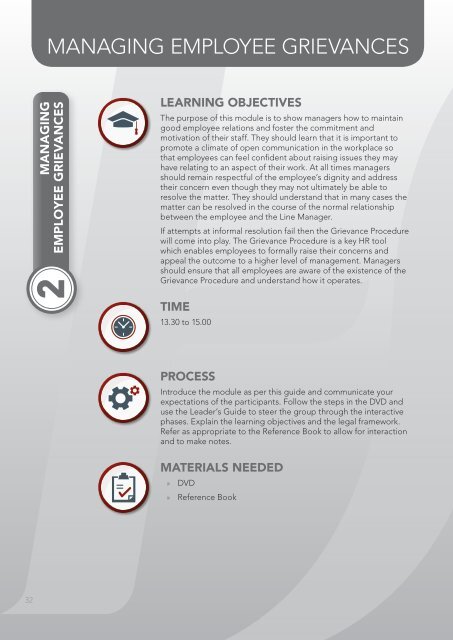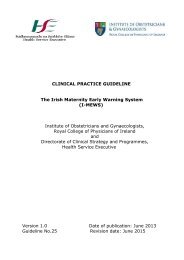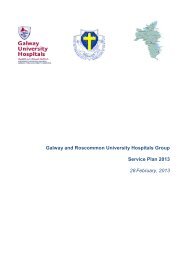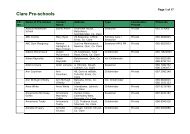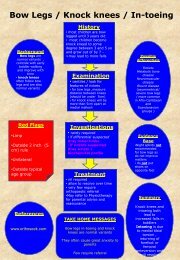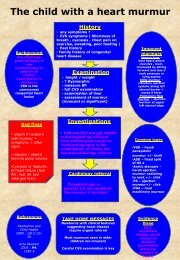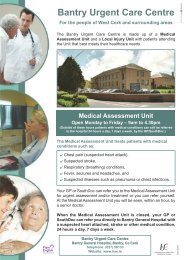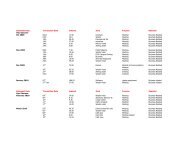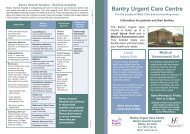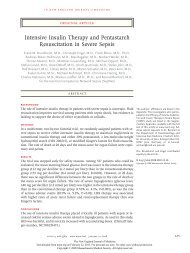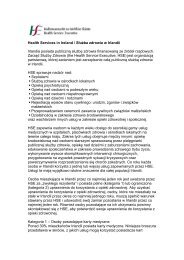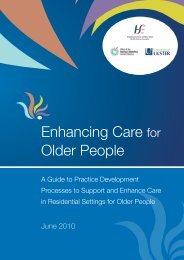ManaGinG eMPLoYee GrieVanCes - Health Service Executive
ManaGinG eMPLoYee GrieVanCes - Health Service Executive
ManaGinG eMPLoYee GrieVanCes - Health Service Executive
Create successful ePaper yourself
Turn your PDF publications into a flip-book with our unique Google optimized e-Paper software.
Managing Employee Grievances<br />
MANAGING<br />
EMPLOYEE GRIEVANCES<br />
Learning Objectives<br />
The purpose of this module is to show managers how to maintain<br />
good employee relations and foster the commitment and<br />
motivation of their staff. They should learn that it is important to<br />
promote a climate of open communication in the workplace so<br />
that employees can feel confident about raising issues they may<br />
have relating to an aspect of their work. At all times managers<br />
should remain respectful of the employee’s dignity and address<br />
their concern even though they may not ultimately be able to<br />
resolve the matter. They should understand that in many cases the<br />
matter can be resolved in the course of the normal relationship<br />
between the employee and the Line Manager.<br />
If attempts at informal resolution fail then the Grievance Procedure<br />
will come into play. The Grievance Procedure is a key HR tool<br />
which enables employees to formally raise their concerns and<br />
appeal the outcome to a higher level of management. Managers<br />
should ensure that all employees are aware of the existence of the<br />
Grievance Procedure and understand how it operates.<br />
Time<br />
13.30 to 15.00<br />
Process<br />
Introduce the module as per this guide and communicate your<br />
expectations of the participants. Follow the steps in the DVD and<br />
use the Leader’s Guide to steer the group through the interactive<br />
phases. Explain the learning objectives and the legal framework.<br />
Refer as appropriate to the Reference Book to allow for interaction<br />
and to make notes.<br />
Materials Needed<br />
»»<br />
»»<br />
DVD<br />
Reference Book<br />
32
Module 2 – Managing Employee Grievances<br />
Introduction<br />
Show Slide 1:<br />
Show Slide 2:<br />
33
Module 2 – Managing Employee Grievances<br />
Learning Objectives and Legal Framework<br />
Show Slide 3:<br />
Say something like:<br />
Introduce the notion that dealing with grievances is akin to handling conflict. An<br />
organisation which does not handle and resolve its conflict issues appropriately will<br />
see them fester and worsen. Thus, the negative aspects of conflict emerge in ways<br />
which are unexpected and largely uncontrollable.<br />
It is therefore vital to your role as a manager that you keep on top of grievances and<br />
encourage staff to air any perceived wrongs.<br />
Show Slide 4:<br />
Make the point that when this module is over they will:<br />
34<br />
»»<br />
»»<br />
»»<br />
»»<br />
»»<br />
»»<br />
Describe the legal framework<br />
State what a grievance is and the purpose of the Grievance Procedure<br />
Know their role in managing and responding to grievances<br />
Understand the importance of creating an awareness of the Grievance<br />
Procedure amongst employees<br />
Understand the steps involved in the Grievance Procedure<br />
Be able to conduct a Grievance Hearing.
Module 2 – Managing Employee Grievances<br />
Show Slide 5:<br />
Show Slide 6:<br />
Make the following key points:<br />
The legislation underpinning employee grievances is the Industrial Relations Acts<br />
1946-2001, which provides that disputes can be adjudicated upon by a third party<br />
under the state’s industrial relations machinery which consists of:<br />
»»<br />
»»<br />
»»<br />
The Rights Commissioner <strong>Service</strong><br />
The Labour Relations Commission<br />
The Labour Court.<br />
35
Module 2 – Managing Employee Grievances<br />
Show Slide 7:<br />
Say something like:<br />
Rights Commissioners adjudicate on individual grievances/disputes. The types<br />
of issues that would usually be referred to a Rights Commissioner include an<br />
entitlement to incremental credit or the non-grant of a public holiday. They do not<br />
hear disputes concerning rates of pay, hours or times of work of a body of workers.<br />
The Labour Relations Commission attempts to conciliate disputes. If the dispute<br />
cannot be resolved at conciliation the matter can then be referred to the Labour<br />
Court.<br />
The Labour Court mainly investigates collective grievances and disputes. It is<br />
viewed as a “court of last resort”.<br />
Make the following key point:<br />
»»<br />
Ireland has a well developed industrial relations structure. Therefore we must<br />
have well developed policies and procedures to match this structure.<br />
TRAINER NOTE<br />
As a manager, you want to avoid employee complaints ending-up before a third party.<br />
However, there may be occasions when a referral is made, despite your best efforts to<br />
resolve the issue. In the event that an employee refers a dispute to a third party, you<br />
must fully cooperate with the process and respect the employee’s right to seek redress.<br />
36
Module 2 – Managing Employee Grievances<br />
Defining a Grievance<br />
Show Slide 8:<br />
Say something like:<br />
Before we look at how to deal with a grievance it is useful to define what we mean<br />
by the word grievance. It may be defined as…<br />
Show and Read Slide 9:<br />
37
Module 2 – Managing Employee Grievances<br />
Show and Read Slide 10:<br />
Run the Brainstorm activity.<br />
With the group in open session brainstorm the issues that give rise to grievances.<br />
Make the point that the following list is not exhaustive.<br />
Show and Read Slide 11:<br />
Show Slide 12:<br />
One-sentence grievances from<br />
different staff including “Why<br />
do I always get to do the filing?”;<br />
“Why is this office always so<br />
stuffy?”; “Why can I never take<br />
annual leave at Christmas?”<br />
38
Module 2 – Managing Employee Grievances<br />
Resolving Grievances Informally<br />
Show Slide 13:<br />
Say something like:<br />
The Grievance Procedure is the formal mechanism for progressing employee<br />
grievances. However it is more beneficial both for the employee and you if issues<br />
can be resolved informally.<br />
Show Slide 14:<br />
Say something like:<br />
The first step to ensuring that employees’ grievances are resolved informally is to<br />
promote a climate of open communication. You should be approachable and open<br />
to listening to your employees. This way employees who have a grievance will firstly<br />
raise it with you directly.<br />
Most routine grievances are capable of being resolved in this manner.<br />
39
Module 2 – Managing Employee Grievances<br />
Show Slide 15:<br />
Say something like:<br />
You need to listen carefully to what the employee’s grievance is and make a genuine<br />
effort to resolve it.<br />
»»<br />
»»<br />
Don’t be too hasty with your reply, and<br />
Give serious consideration to their concerns.<br />
Show and Read Slide 16:<br />
40
Module 2 – Managing Employee Grievances<br />
Show Slide 17:<br />
Say something like:<br />
Grievances can escalate because a grievance that the employee has raised is<br />
dismissed too easily.<br />
Show Slide 18: Chris Playlet, Segment 1<br />
Chris is the manager of a busy<br />
clinic. Una complains that her<br />
cramped office is affecting<br />
her work, but because of her<br />
reputation he dismisses her<br />
complaint, due to an initial<br />
reaction of “Oh no, not again”.<br />
41
Module 2 – Managing Employee Grievances<br />
Show Slide 19:<br />
TRAINER NOTE<br />
Discuss with the group what Chris sees when this young woman presents her complaint. Is he<br />
as positively disposed to her complaint as he might be? Emphasise that he has already made<br />
up his mind that she is a difficult person to deal with. As a result he is at a disadvantage in<br />
trying to deal with her grievance, i.e. he immediately dismisses her grievance.<br />
Show Slide 20: Chris Playlet, Segment 2<br />
Chris did not appreciate how<br />
upset Una was, and he was<br />
stunned to receive a letter from<br />
the <strong>Health</strong> and Safety Authority<br />
two weeks later. He looked into<br />
the problem and organised a<br />
clean-up day.<br />
42
Module 2 – Managing Employee Grievances<br />
Show and Read Slide 21:<br />
Show and Read Slide 22:<br />
43
Module 2 – Managing Employee Grievances<br />
Show Slide 23:<br />
Say something like:<br />
What’s the key word in this Case Study?<br />
(The answer is that this word is “immediately.” The manager makes up her mind<br />
too quickly and without due consideration.)<br />
Ask what are the potential consequences of Gráinne’s reactions. Some suggestions<br />
may be:<br />
»»<br />
»»<br />
»»<br />
»»<br />
»»<br />
The matter remains unresolved<br />
It may interfere with what were good working relationships between Gráinne<br />
and Margaret<br />
The development of poor attitude to work<br />
Her negativity may rub off on her colleagues<br />
She might go out sick.<br />
Show and Read Slide 24:<br />
44
Module 2 – Managing Employee Grievances<br />
Show and Read Slide 25:<br />
Say something like:<br />
Remember this slide is the antidote to “immediately.”<br />
Show Slide 26:<br />
Say something like:<br />
Despite your best efforts some grievances can’t be resolved informally. These<br />
should be directed to the formal Grievance Procedure. Advise the employee<br />
accordingly of the steps in this procedure.<br />
45
Module 2 – Managing Employee Grievances<br />
The Grievance Procedure<br />
Show Slide 27:<br />
Say something like:<br />
The Grievance Procedure is for everyone in the <strong>Health</strong> <strong>Service</strong>. It exists to deal<br />
promptly and fairly with individual employee grievances which have not been<br />
resolved through the normal working relationship.<br />
These grievances mostly relate to:<br />
»» Working environment<br />
»» Terms and conditions or<br />
»» Workplace relationships.<br />
A National Grievance Procedure has been agreed for the <strong>Health</strong> <strong>Service</strong>. It is a<br />
staged procedure which allows an employee to pursue resolution of their grievance<br />
up through the management structures.<br />
Show Slide 28:<br />
46<br />
Make the following key points:<br />
You have a responsibility for creating an awareness of the Grievance Procedure in<br />
your Department. Therefore you should ensure that your employees:<br />
»» Are made aware of the existence of the Grievance Procedure<br />
»» Have the procedure explained to them. For new employees this may be<br />
covered at their induction<br />
»» Are encouraged to use the procedure where appropriate.
Module 2 – Managing Employee Grievances<br />
TRAINER NOTE<br />
Before running the next playlet emphasise to the participants that Billy looks after<br />
very vulnerable people and his presence during the full shift is vital.<br />
Show Slide 29: Billy Playlet<br />
Billy is a Care Worker in a<br />
residential care setting. He asks<br />
his supervisor if he can change<br />
his roster to facilitate his parttime<br />
studies and some exams.<br />
She refuses, and he feels she<br />
is ignoring the importance of<br />
the exams to him. As a result he<br />
leaves work an hour early one<br />
day without permission.<br />
Show Slide 30:<br />
Say something like:<br />
Ask participants what action they would take in this situation and does the blame lie<br />
solely with Billy? Are there are any steps Billy’s manager could have taken to prevent<br />
this from happening?<br />
47
Module 2 – Managing Employee Grievances<br />
Show Slide 31:<br />
Say something like:<br />
An important element of the Grievance Procedure is the “working under protest”<br />
provision. It’s there to cover situations where you issue a work instruction arising<br />
from an urgent service imperative which an employee objects to on the basis that it<br />
is outside their normal remit. In these cases the employee is obliged to carry out the<br />
instruction “under protest”.<br />
For example if a Porter in A&E is asked to go to Theatre due to staff shortages there<br />
and refuses to go as this is not his/her normal work location, he/she must carry<br />
out the disputed duty(ies) “under protest” and refer the matter under the Grievance<br />
Procedure.<br />
This provision was negotiated with their trade union at national level and should be<br />
enforced by you.<br />
48
Module 2 – Managing Employee Grievances<br />
Show Slide 32:<br />
Make the following key points:<br />
»»<br />
»»<br />
»»<br />
If this happens a meeting with senior management will be held within 3 working<br />
days of the grievance being received to determine if the instruction(s) given by<br />
you was/were appropriate<br />
Senior management in this context refers to either senior line management or<br />
the Human Resources department<br />
If the issue cannot be resolved at this stage, the matter may be referred to a<br />
third party.<br />
Show Slide 33:<br />
Say something like:<br />
To commence the procedure the employee must write to their Line Manager giving<br />
brief details of their complaint and that they wish the matter to be progressed<br />
through the Grievance Procedure.<br />
Every effort should be made by both parties to resolve the matter as speedily as<br />
possible.<br />
The employee should also be given the chance to state their case fully without fear<br />
of repercussion.<br />
49
Module 2 – Managing Employee Grievances<br />
Show Slide 34:<br />
Say something like:<br />
Stage 1<br />
This is the first step in the Grievance Procedure. Under Stage 1 the employee must<br />
outline their grievance in writing to their Line Manager.<br />
Stage 2<br />
If agreement cannot be reached at Stage 1, the matter may be referred to a more<br />
senior level of management under Stage 2 of the procedure.<br />
Stage 3<br />
If agreement cannot be reached at Stage 2 the matter may be referred to the<br />
Human Resources department under Stage 3 of the procedure.<br />
Show Slide 35:<br />
Make the following key points:<br />
50<br />
At Stages 1-3 of the Grievance Procedure the following arrangements apply:<br />
»» A meeting will be arranged within 7 working days to consider the grievance<br />
»» Ensure that the employee knows they have a right to representation<br />
»» Keeping records at the meeting is critical<br />
»» Following the meeting the employee must have a written decision conveyed to<br />
him/her within 7 working days.
Module 2 – Managing Employee Grievances<br />
Show Slide 36:<br />
Say something like:<br />
If the issue is not resolved at the earlier stages the matter may be brought to Stage<br />
4, i.e. it is referred to one of the following external third party/parties:<br />
»»<br />
»»<br />
»»<br />
»»<br />
Rights Commissioner<br />
Labour Relations Commission<br />
Labour Court<br />
Equality Tribunal.<br />
Show Slide 37:<br />
Say something like:<br />
Where you have been unable to resolve a grievance informally you may find yourself<br />
part of a Grievance Hearing, where the employee is challenging a decision that you<br />
have made.<br />
51
Module 2 – Managing Employee Grievances<br />
Show Slide 38:<br />
Say something like:<br />
If this does occur you may have to testify why the matter was not capable of being<br />
resolved informally. Be prepared – explain why you came to your decision.<br />
In this context it would be useful to keep an informal note if employees do raise<br />
grievances informally.<br />
Make the following key point:<br />
»»<br />
Guidelines on how to conduct a Grievance Hearing are contained within the<br />
Reference Book<br />
Show Slide 39: Alan Playlet<br />
Alan is a Lead EMT. One of his<br />
employees, Peter, spends a lot<br />
of his “on call” duty on the golf<br />
course, which could delay his<br />
response time. Alan raises it for<br />
the first time when Peter comes<br />
to him about something else.<br />
Peter said he was unaware of the<br />
problem as no one had spoken<br />
to him about it. Alan gives him a<br />
warning.<br />
52
Module 2 – Managing Employee Grievances<br />
Show Slide 40:<br />
Say something like:<br />
What has Alan done here? Is he procedurally wrong? What is the likely outcome of<br />
this situation – (Peter now has two grievances!)<br />
Show Slide 41:<br />
Say something like:<br />
Under no circumstances should the Grievance Hearing be used as an opportunity<br />
to address shortcomings in an employee’s work performance or conduct which the<br />
manager was reluctant to confront previously.<br />
53
Module 2 – Managing Employee Grievances<br />
Show Slide 42:<br />
Show and Read Slide 43:<br />
Show Slide 44:<br />
54<br />
Say something like:<br />
If you wish to deal with an issue relating to a staff member’s performance, make<br />
sure you take the initiative on this matter and deal with it as a separate process, i.e.<br />
through informal counselling or the Disciplinary Procedure.
Module 2 – Managing Employee Grievances<br />
Show and Read Slide 45:<br />
Show and Read Slide 46:<br />
Take Break from 15.00 to 15.15<br />
Transition to Managing Attendance<br />
55


